|
Reminiscences of Old Arborfield
As told by Miss A. M. Edwards
This article appeared in the 1973 edition of 'Your
Village'. The comments in round brackets date from 1973, not the 21st
Century!
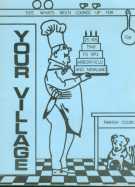 A number of Arborfield residents have enjoyed hearing
a first-hand account – given with characteristic humour and enthusiasm –
of life in Arborfield sixty years ago by Miss Edwards, a former resident
of the village, an ex-secretary of the P.C.C. and now a retired
headmistress. A number of Arborfield residents have enjoyed hearing
a first-hand account – given with characteristic humour and enthusiasm –
of life in Arborfield sixty years ago by Miss Edwards, a former resident
of the village, an ex-secretary of the P.C.C. and now a retired
headmistress.
The following is an attempt to portray some aspects of
life here at that time for the benefit of a wider public. It is seen
through the eyes of a schoolgirl and recorded for posterity by a current
resident....
Arborfield was then a very small and compact village centred round the
cross with only a few houses in Lower Arborfield, none in Church Lane,
and only Cross Lanes Farm on the main road between Greensward Lane and
the Cross.
Miss Edwards lived in one of the two cottages opposite the
Grange gates, then known as the Grange Cottages and now as
Bridge Farm Cottages, as her father was successively coachman, groom
and chauffeur to the Rickman family who then occupied the Grange.
This part of the village was always badly drained and Church Lane was
frequently flooded in winter, as was the main road to Shinfield. On one
great occasion, there was even skating on the meadows beyond the bridge.
The main road, like Walden Avenue used to be, had large pot holes making
huge puddles in winter and in summer causing clouds of dust. Apart from
a few steam engines, traffic was largely horse-drawn carts, wagons,
wagonettes, broughams, etc., and it was the practice to scatter a load
of straw on the road outside the house of anyone who was ill, to quieten
the traffic noise! However, by present-day standards, life was
relatively peaceful!
There was, of course, no bus service to Reading and one either had to
walk or go by carrier’s cart,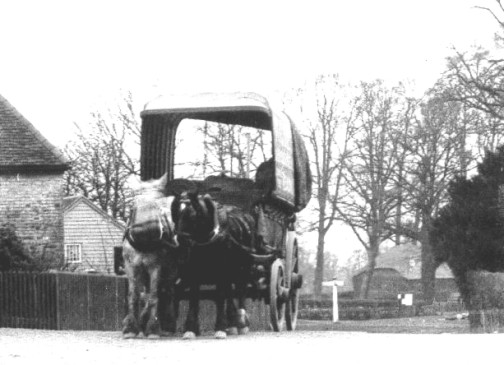 room permitting. Alternatively the carriers – Fullbrook of
Arborfield (who lived at the Pheasantries), Maybanks of
Finchampstead or Baylis of Barkham – would do one’s shopping
instead. Day-to-day needs were catered for by Mr. Seymour the
grocer, on the site of the present stores, by Miles the butcher from
Shinfield, and by a baker’s cart. Mr. Mattingley presided at
the Post Office and the Garratt brothers ran a thriving building
and decorating business behind the present bus shelter [removed in 2004
when the roundabout was completed]. The village also supported a
blacksmith – next to the Post Office – a wheelwright bearing the
well-known name of Bentley (Mr. Guy Bentley’s father) and even a
tailor by the name of Tayler. In sickness the villagers were
attended by Dr. Walker from Swallowfield Grange travelling on
horseback or by pony and trap.
room permitting. Alternatively the carriers – Fullbrook of
Arborfield (who lived at the Pheasantries), Maybanks of
Finchampstead or Baylis of Barkham – would do one’s shopping
instead. Day-to-day needs were catered for by Mr. Seymour the
grocer, on the site of the present stores, by Miles the butcher from
Shinfield, and by a baker’s cart. Mr. Mattingley presided at
the Post Office and the Garratt brothers ran a thriving building
and decorating business behind the present bus shelter [removed in 2004
when the roundabout was completed]. The village also supported a
blacksmith – next to the Post Office – a wheelwright bearing the
well-known name of Bentley (Mr. Guy Bentley’s father) and even a
tailor by the name of Tayler. In sickness the villagers were
attended by Dr. Walker from Swallowfield Grange travelling on
horseback or by pony and trap.
The “Bull” was kept by the two Miss Radburns, who later
retired to the thatched almshouses in Greensward Lane which have
recently been pulled down.
The Garrison was then known as the Remount Depot where mules from
Ireland and horses were broken in and trained, and from which they would
occasionally stray!
 This was before the days of the village hall, and meetings were held in
the Reading Room in Church Lane. These included Sunday School,
Mother’s Union and “Mothers’ Meetings” (a forerunner of the present
Wives’ Group?) at which rolls of material provided by the ladies of the
village were sold cheaply and made into garments whilst one of the
ladies read aloud. This was before the days of the village hall, and meetings were held in
the Reading Room in Church Lane. These included Sunday School,
Mother’s Union and “Mothers’ Meetings” (a forerunner of the present
Wives’ Group?) at which rolls of material provided by the ladies of the
village were sold cheaply and made into garments whilst one of the
ladies read aloud.
Life in the village centred very much round the Grange and the
Hall. Arborfield Hall stood in a prominent position in the park
close to the river on the site where a new house has recently been
erected for the Director of the N.I.R.D. The Hall has only been
demolished in the last twenty years. At this time it was the home of a
Mrs. Hargreaves, said to be a descendant of the James
Hargreaves who invented the “Spinning Jenny” in 1764.
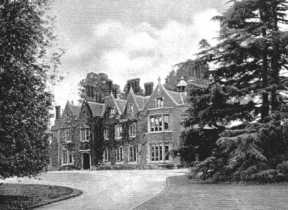
This lady is
said to have been a somewhat formidable character who travelled about by
pony-chaise and occupied a privileged seat in the chancel of the church.
She provided a summer fete for the children of Arborfield and Newland
who would assemble at the Lodge gates and march down the park behind a
band.
They would be met by Mrs. Hargreaves seated at the entrance of the
Hall in her bonnet and attended by her maid, and they would sing “The
Minstrel Boy”, “The Ash Grove” and “Land of Hope and Glory”.
After this
performance they would line up, curtsey, and be rewarded for their
efforts with a handful of gingerbread biscuits.
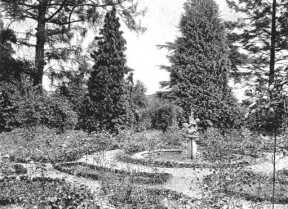
After this, they were
free to roam around the grounds, to enjoy the swing-boats specially
imported from Reading, or to take part in races, before it was time for
tea, which was laid out on long tables. This would be followed by more
games and races, after which prizes and gifts would be presented on the
terrace.
About seven o’clock, parents were allowed in to wander around
the grounds. At that time, Arborfield boasted a cricket team which
played its matches in the park.
At the Grange, Captain and Mrs. Stuart Rickman took a great
interest in the children and in all the people of the village where they
were greatly respected. Their nephew, Philip Rickman, is now a
famous bird artist. They provided a Christmas treat for the children
every year when a sumptuous tea was prepared in the Grange kitchens.
This was followed by an entertainment consisting of either
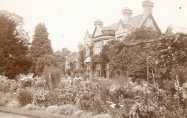 a Punch and
Judy Show or a conjuror and ventriloquist from Reading. a Punch and
Judy Show or a conjuror and ventriloquist from Reading.
The girls were
given new scarlet cloaks made in the Grange and the boys grey jerseys.
The Rickmans were great supporters of the church and each Christmas gave
everyone in the village a present which ranged from a brace of pheasants
to an iced cake or a tin according to their “station”.
The Grange was
also the scene of “marvellous” private parties, with marquees on the
lawn, cans of cream and once a bagpipe band brought specially from
Scotland.
The school at that time had newly moved from the small premises in
Greensward Lane – now two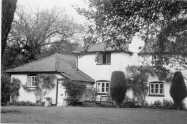 houses – to the present site in School Road.
The school building comprised four rooms, one divided by a curtain, and
heated with open fireplaces. One room was set aside as a play room which
the children could use before school or when it was wet at playtime.
They also had swings in the houses – to the present site in School Road.
The school building comprised four rooms, one divided by a curtain, and
heated with open fireplaces. One room was set aside as a play room which
the children could use before school or when it was wet at playtime.
They also had swings in the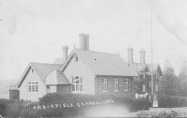 playground. playground.
“Jimmy” Hayward, the
headmaster, allowed the children to bring potatoes to bake in the ashes
of the open fireplaces and in the winter allowed them to slide on the
frozen pond.
Perhaps the winters were colder then, as it happened quite
often. It presented a colourful picture, with the girls in their scarlet
cloaks, and it says something for their standards of behaviour in that
supervision was considered unnecessary.
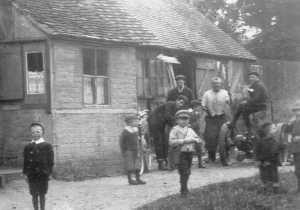
In their dinner hour, the children would catch minnows and tadpoles in
the pond at the bottom of the road, scramble across the fields to fill
their
 satchels with chestnuts in “Chestnut Park”, or watch horses
being shod at the smithy. satchels with chestnuts in “Chestnut Park”, or watch horses
being shod at the smithy.
On the other hand, the girls in their black
stockings and button-up boots were expected to curtsey to everyone “from
the rector upwards”!
The church featured largely in their lives at that time, and a thriving
and competent choir even attracted people from Reading. A retinue of
servants from the “big houses”, with the maids in black bonnets and long
black skirts would sit in special pews and after the service the
children would often go for a walk through “Parfitt’s Farm” (now
Bridge Farm) and round Pound Copse.
The annual choir outing was a
major event. During the First World War they were limited to places like Streatley, but afterwards it was a day at the sea at Southsea or
Ramsgate. This called for a 5.a.m. start from the Cross in Mr. Bowyer’s
farm wagon from Newlands Farm, which took them to Wokingham Station and
brought them home again at about midnight. Choir Practice was first held
in the home of “Teacher Frances” (now Mrs. Edwards who, at 92, is
one of the oldest inhabitants, and still [in 1973] active in the village) and
later in the school.
Other meetings – the Monday “Band of Hope”, and the “Sewers’ Band” were
held at the Rectory. The children would be escorted there by “Aunty
Kate” – Mrs. Kate Emblen, the mother of our well-known Harry Emblen
who now lives in South Africa but still closely follows the affairs of
the village. She was a great church worker and would regularly walk with
the children from Swallowfield Road to the Rectory and back carrying a
lantern with a candle in it to light the way.
At the “Sewers’ Band” the
girls would make various items for a sale of work at Reading Town Hall.
During the war they would also join a Saturday working party at the
Grange making roll bandages from yards of unbleached calico whilst the
ladies made hospital shirts.
They would also display their handiwork at the Arborfield and Newland
Flower Show, held in a marquee at Newlands. A standard work in their
repertoire was a Nainsook pinafore with wide lace across the chest and
over the shoulders. Another feature of the flower show was a prize for
the best kept garden.
Other local excitements included the Annual Blackwater Fair, when
herds of cattle were driven through the village from Reading Station.
Tramps seeking hot water for tea, and pedlars, were quite common. The
latter included a weekly Friday visit of a barrel organ and monkey from
Silver Street in Reading. These were carried on a donkey cart and the
children would love to turn the handle of the organ.
Another regular was
the collector of ‘jam jars and bottles’, for which windmills were given.
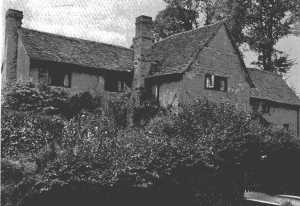
Another local character was “Blind John of Arborfield” who lived
in the centre one of three very poor cottages by the bridge – later
converted and modernised to become ‘Bridge House’.
John could find his
way to Arborfield with no difficulty (traffic was rather less of a
problem then) where the charitable residents gave him money which he
kept in a calico bag.
He was a great whistler, and when he was not
whistling, he was said to be swearing! When he died the villagers
subscribed for a stone in the churchyard on which his whistling is
recorded.
Yes, life in Arborfield has certainly changed since those days; but I
wonder if ALL the changes have been for the better?
[End of 'Your Village' Article]
Back to Memories Page

|

